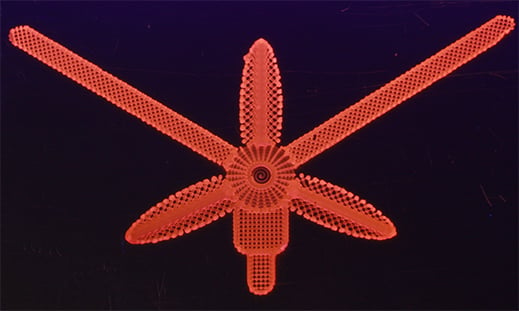Gorgeous New 4-D Printing Process Makes More Than Just Eye Candy
If you are tired of the hype around 3-D printing, brace yourself, because it’s time to add another “D.” Yesterday, researchers unveiled a new process they can use to “4-D print” flat objects that change into complex shapes when they are immersed in water.

The new demonstration builds on the microscale printing process developed under the leadership of Jennifer Lewis, a materials scientist at Harvard. The images are captivating, but they aren’t just pretty pictures; they also hint at a fundamental new capability that could be applied in useful ways.
This is not the first time we’ve heard about 4-D printing, which refers to printing things that are “programmed” to change shapes later on. Three years ago Skylar Tibbits, a research scientist in MIT’s architecture department, introduced the term at the TED Conference. Tibbits’s process employed two materials, a rigid one and a softer one that expands when put in water.
Lewis and her colleagues have developed a simpler process based on a single new material, a composite made of a gel-like substance combined with tiny fibers of cellulose. The stiffness of these fibers, and the degree to which they swell in water, varies depending on how they are aligned. The researchers exploit that to “encode” the ability to change into a complex, prescribed shape. Lewis says it should be possible to use the new process, with a different hydrogel ink, to make objects that change shape in response to other stimuli, like light. The cellulose fibers could also be switched out for conductive materials to make electronic devices, she says.
This general approach might prove useful for tissue engineering. But let’s not get carried away—this in itself brings us no closer to “replacement organs.” A big challenge is developing 3-D scaffolds for growing new cells and tissues to help in making tissue repairs. Lewis says the group is already exploring this in the lab, by growing cells on flat structures and then triggering shape changes later on, for example by placing them in a wound site.
(Sources: Harvard, New Scientist)
Keep Reading
Most Popular
Large language models can do jaw-dropping things. But nobody knows exactly why.
And that's a problem. Figuring it out is one of the biggest scientific puzzles of our time and a crucial step towards controlling more powerful future models.
The problem with plug-in hybrids? Their drivers.
Plug-in hybrids are often sold as a transition to EVs, but new data from Europe shows we’re still underestimating the emissions they produce.
Google DeepMind’s new generative model makes Super Mario–like games from scratch
Genie learns how to control games by watching hours and hours of video. It could help train next-gen robots too.
How scientists traced a mysterious covid case back to six toilets
When wastewater surveillance turns into a hunt for a single infected individual, the ethics get tricky.
Stay connected
Get the latest updates from
MIT Technology Review
Discover special offers, top stories, upcoming events, and more.